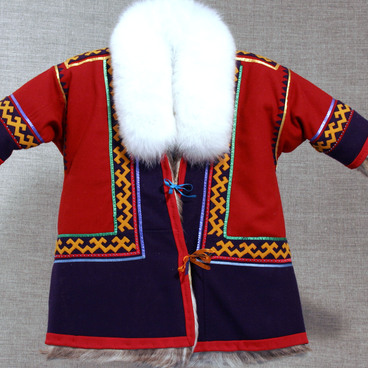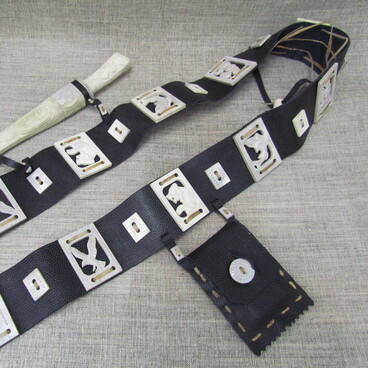A mAlitsa, a done up male coat made of processed reindeer hides with fur in, is the most well-known item of the NEnets clothing. This coat helps surviving the severest frosts. A malitsa is worn straight on the body. Adjacent to a body, long and hollow reindeer piles create a special microclimate and keep warmth. Fur also absorbs excessive moisture as it touches the skin. A mAlitsa coat is worn with a composed belt made of reindeer leather with a knife in a scabbard, a grindstone in a special poach, an awl and small bone harness details attached to the belt.
For a long time, many NEnets put a cloth shirt over a mAlitsa coat to protect it from dampness, dirt and sunrays. It has the same design as a mAlitsa. The front and the back parts are cut out of a solid piece of cloth, they get a bit wider at the bottom, the front part is somewhat shorter, the sleeves are wider at the shoulders. The overshirt doesn’t have a hood, men put on a doubled mAlitsa hood if necessary.
To make a mAlitsa overshirt, the Forest NEnets use cloth of traditional colors — blue, green or red. Neck, cuff and lap parts are decorated with a contrasting ornament. Cloth patterns technique is the same as of fur ornaments. Two contrasting pieces equal in shape mirror each other and are sewn together with fine whip stitches. Additionally, they use applique, sewing a contrasting ornament over the cloth of a basic color.
Each color of the clothing has its meaning by the Forest Nenets. For instance, green is the color of grass, spring and summer, red means fire, warmth or blood, the beginning of life. Those who wear clothes ornamented with red strips carry fire, warmth and light with them.
A malitsa overshirt in the museum exposition was provided by Khovku Pyak, a Dyanki-Koy camp resident. It is made of traditional green cloth decorated with red ornament. A contrasting strip is sewn to the cuffs and the lap, the neck has a triangular ornament.
For a long time, many NEnets put a cloth shirt over a mAlitsa coat to protect it from dampness, dirt and sunrays. It has the same design as a mAlitsa. The front and the back parts are cut out of a solid piece of cloth, they get a bit wider at the bottom, the front part is somewhat shorter, the sleeves are wider at the shoulders. The overshirt doesn’t have a hood, men put on a doubled mAlitsa hood if necessary.
To make a mAlitsa overshirt, the Forest NEnets use cloth of traditional colors — blue, green or red. Neck, cuff and lap parts are decorated with a contrasting ornament. Cloth patterns technique is the same as of fur ornaments. Two contrasting pieces equal in shape mirror each other and are sewn together with fine whip stitches. Additionally, they use applique, sewing a contrasting ornament over the cloth of a basic color.
Each color of the clothing has its meaning by the Forest Nenets. For instance, green is the color of grass, spring and summer, red means fire, warmth or blood, the beginning of life. Those who wear clothes ornamented with red strips carry fire, warmth and light with them.
A malitsa overshirt in the museum exposition was provided by Khovku Pyak, a Dyanki-Koy camp resident. It is made of traditional green cloth decorated with red ornament. A contrasting strip is sewn to the cuffs and the lap, the neck has a triangular ornament.




